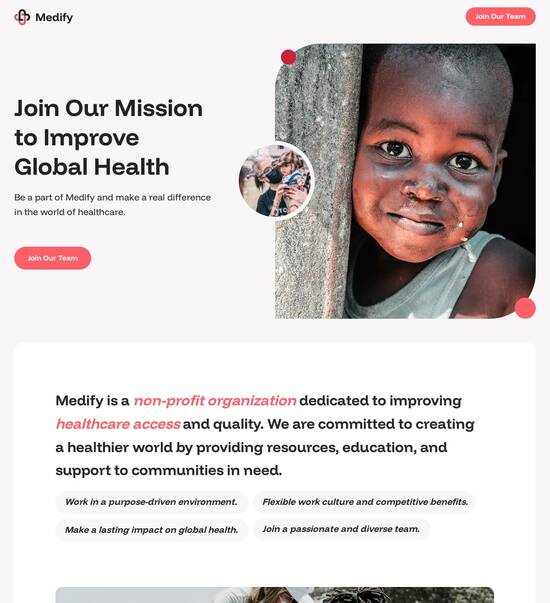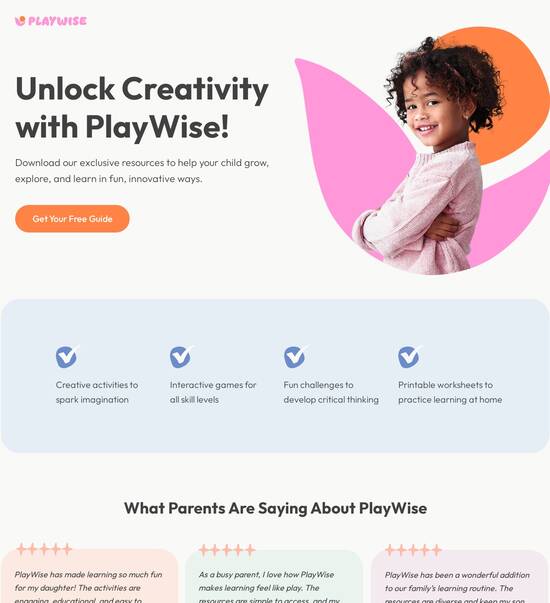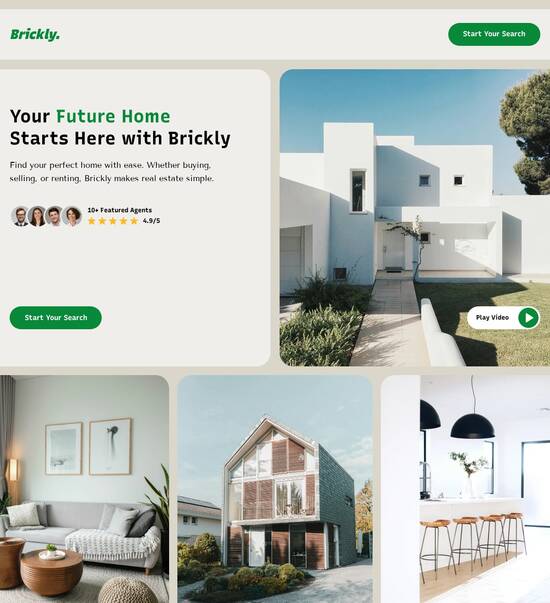
HTML/CSS optimized collaboration page template
Explore Similar TemplatesAbout template
Supercharge your collaboration page with HTML/CSS for outstanding performance! Learn more today.
Recommended templates

Easy to build without coding
With the intuitive drag-and-drop builder, anyone on your team can create high-converting pages without any knowledge of code or design. Make enhancements to your landing page with custom widgets using Javascript, HTML/CSS, or third-party scripts.

Multiple layouts for any industry and goal
Select from 500+ landing page layouts built to boost conversions across industry-specific scenarios. Customize them by adjusting fonts, adding images, and generating on-brand content with the AI assistant. Quickly scale with Instablocks® and Global Blocks that you can save, reuse, and update globally.

Loads fast and looks polished on any device
Every template is responsive, which means they present professionally on any device and load blazingly fast with our Thor Render Engine. You can also power them up with Google AMP technology to deliver an unparalleled mobile experience and drive higher conversions.

Robust analytics & experimentation
Get real-time updates and reporting across all your devices, showing the number of visitors, conversions, cost-per-visitor, and cost-per-lead. Launch AI-powered experiments, run A/B tests, and use heatmaps to analyze user behavior, then optimize your landing page to maximize conversions.







Easy to build without coding
With the intuitive drag-and-drop builder, anyone on your team can create high-converting pages without any knowledge of code or design. Make enhancements to your landing page with custom widgets using Javascript, HTML/CSS, or third-party scripts.
Multiple layouts for any industry and goal
Select from 500+ landing page layouts built to boost conversions across industry-specific scenarios. Customize them by adjusting fonts, adding images, and generating on-brand content with the AI assistant. Quickly scale with Instablocks® and Global Blocks that you can save, reuse, and update globally.
Loads fast and looks polished on any device
Every template is responsive, which means they present professionally on any device and load blazingly fast with our Thor Render Engine.
Robust analytics & experimentation
Get real-time updates and reporting across all your devices, showing the number of visitors, conversions, cost-per-visitor, and cost-per-lead. Launch AI-powered experiments, run A/B tests, and use heatmaps to analyze user behavior, then optimize your landing page to maximize conversions.
All the features you need to build lead-generating landing pages
Explore more featuresLearn how to build top-performing landing pages for any goal
FAQs
Leading the way in building high-performing landing pages





A step-by-step guide to mastering Instapage for landing pages and CRO
Instapage stands out as a powerful tool for landing pages and conversion rate optimization (CRO). With its innovative features, marketers can accelerate their campaigns, optimize for maximum ROI, and scale effectively. This guide walks you through the essential steps to leverage Instapage in achieving your digital marketing goals, focusing particularly on its capabilities tailored to various sectors including tech, education, and financial services.
Understanding Instapage's key features
Instapage offers users an intuitive platform for crafting high-converting landing pages. By exploring its key features, you'll understand why it's the preferred choice for marketers aiming to boost their campaign effectiveness, without needing deep technical skills.
- Templates & Lead Gen Elements: Utilize over 100 high-converting templates and pre-built lead generation tools to create pages swiftly.
- Landing Pages: Build pages with 100+ customizable layouts using Instablocks, allowing for quick design without coding.
- Optimization Tools: Access built-in experimentation options, including A/B testing and heatmaps, to analyze user behavior and improve conversion rates.
Step 1: Creating your landing page
Begin your journey by setting up a landing page in Instapage. Its user-friendly interface enables quick creation. Here’s how to get started:
- Select a Template: Choose a high-converting template that fits your campaign objective.
- Customize Elements: Tailor the template using intuitive builders, adapting text, images, and layout to better target your audience.
- Preview and Publish: Utilize the preview feature to ensure your page renders well on all devices, then publish it directly.
Step 2: Optimize with experimentation tools
After your page is live, the next step is optimizing it for conversions. Focus on experimenting with different elements to find what resonates best with your audience.
- Implement A/B Testing: Test different headlines, call-to-action buttons, or images to determine which version performs better.
- Analyze Heatmaps: Use heatmaps to visualize visitor behavior on your page, identifying which elements attract the most attention.
- Use Analytics Dashboard: Monitor performance metrics to measure conversion rates and refine your approach continuously.
Step 3: Personalizing user experience
Lastly, leverage Instapage's personalization tools to deliver tailored experiences. Personalization can significantly enhance user engagement and conversion.
- Dynamic Text Replacement: Customize page content dynamically based on visitor data like location or referral source.
- AdMaps Feature: Align specific ads to unique pages, facilitating a seamless journey from ad click to landing page.
- Track Audience Metrics: Use data tools to analyze how different segments interact with your pages and optimize accordingly.
By following these steps, you can effectively utilize Instapage to maximize your landing page performance and optimize conversion rates.
Ready to enhance your marketing strategy? Explore Instapage today and transform how you engage your audience.
People also ask about HTML/CSS optimized collaboration page template
HTML/CSS optimized collaboration page template: A comprehensive guide
Understanding the features of an optimized HTML/CSS collaboration page template
When we discuss HTML/CSS collaboration page templates, we refer to pre-designed frameworks built using Hypertext Markup Language (HTML) and Cascading Style Sheets (CSS). These templates serve as blueprints, allowing businesses to create customizable web pages tailored to enhance team collaboration. As teams grow and work across different geographies, the need for effective collaboration tools becomes fundamental for any organization.
HTML provides the structure and content of web pages, while CSS handles the aesthetics and layout, bringing a page to life. In today's interconnected world, using various collaboration tools is vital for promoting teamwork and enhancing productivity.
Ease of use for team members with varying technical skills.
Quick adaptation to changes and feedback for rapid project evolution.
Integration with existing tools like project management and document sharing applications.
Enhancing user experience with dynamic elements
A collaboration page template can be significantly improved by leveraging JavaScript for interactivity. JavaScript allows for real-time updates and engagement, enhancing user experience manifold. The use of `document.addEventListener` plays a crucial role in this context, as it helps in creating a responsive interface by detecting user interactions.
For example, clicking buttons or submitting forms can trigger events that update the user interface without needing a full page refresh. This seamless interaction makes the collaboration experience smoother and more efficient.
Real-time notifications when a document is edited.
Dynamic filtering of tasks or comments based on user preferences.
Responsive chat functionalities for quicker communication.
Creating engaging functionalities through JavaScript functions allows the automation of repetitive tasks. By adopting a modular programming practice, developers can build reusable code snippets that streamline operations. For instance, a common custom function might allow users to automate email notifications every time a new project is created.
Moreover, to improve performance, implementing asynchronous loading techniques—for instance, using IOLazy for images and videos—becomes essential. This strategy will ensure that media is only loaded when users are likely to view them, significantly enhancing page load speeds and reducing resource consumption.
Step-by-step integration of lazy loading for images and videos.
Ensuring that users only download critical data as needed.
Designing the aesthetics of your collaboration page
The visual aspect of a collaboration page is just as important as functionality. Choosing the right colors can significantly impact user engagement. Different colors evoke different emotions, and understanding this psychological aspect can enable teams to choose palettes that foster collaboration and productivity.
When selecting a color palette, consider a combination of colors that convey professionalism and creativity—tones like blue or green are often associated with trust, while warmer colors can instill excitement. It's essential to create a harmonious balance that aids in user experience.
Using contrasting colors for calls-to-action without overwhelming the design.
Identifying colors that align with the organization's branding.
Font selection is another crucial design element that greatly affects readability and communication. The right fonts can help convey messages clearly and efficiently, reducing viewer fatigue and improving comprehension.
When choosing fonts, selecting a combination of a sans-serif for main content and a more distinctive serif type for headings can create a visually appealing hierarchy that guides users through the page. Aim for font pairings that are legible on all devices—a mobile-friendly design is essential in today’s digital landscape.
Utilizing whitespace effectively to enhance layout.
Avoiding overly decorative fonts that distract from the content.
Building an intuitive template with essential components
Constructing the structure of your collaboration page requires careful consideration of essential components. The header is often the first impression users get, so it needs to be both visually appealing and functional.
Key elements of a well-designed header include a clear logo, navigation links, and possibly a search function. These elements contribute to a good user experience by helping users find what they need quickly.
Incorporating responsive and adaptive navigation.
Aligning branding and purpose through design.
On the flip side, the footer serves as a crucial aspect in maintaining usability and navigation. It can provide important references such as contact details, FAQs, and links to social media. Including these valuable elements ensures users remain informed and connected with your organization.
Also, the incorporation of responsive design elements is critical in today’s diverse device landscape. Responsiveness ensures that the collaboration page adapts seamlessly to different screen sizes, thus enhancing accessibility and user experience.
Utilizing CSS frameworks like Bootstrap for responsive design.
Testing and modifying templates to fit various devices.
Managing content effectively
Content management is an essential aspect of any collaboration page. Effective text content requirements should focus on clarity, conciseness, and an actionable approach. The aim should be to facilitate communication that drives engagement.
Clear content hierarchy is also essential. Utilize headings, subheadings, and bullet points to organize the information, making it more digestible for users. When writing, always consider the user's perspective—what information do they need to progress with their tasks?
Consistent terminology to avoid confusion.
Interactive content to encourage user participation.
Rich media can further enhance interaction and understanding within a collaboration template. Videos, infographics, and high-quality images can illustrate points concisely while engaging viewers effectively. However, it’s vital to integrate these elements without compromising performance, ensuring users can interact with content fluidly.
Balancing design and content is essential for resolving common issues in layout. Users often struggle when there’s too much text or poorly placed elements. Adopting clean designs with adequate spacing and visual breaks can significantly enhance readability and drive user interaction.
Advanced features for template customization
As collaboration needs evolve, templates must be adaptable. Exploring the power of a template builder can immensely benefit developers. These builders provide access to various features that simplify the design process, such as pre-built elements and layout options.
The primary advantage of using a drag-and-drop interface is that even those without coding experience can create attractive templates. It allows flexibility and creativity in terms of layout while significantly reducing development time.
Integrating design elements like buttons, forms, and sections.
Customizing elements to align with branding requirements.
Creating a download panel is another important feature for collaboration templates. Many projects require access to downloadable resources, such as documents or project briefs. Providing a user-friendly download panel enhances accessibility, allowing users to retrieve necessary files without navigating away from the main page.
Simplifying the download process can significantly enhance user satisfaction, ensuring teams are provided with resources they need at their fingertips.
Performance optimization and browser compatibility
Ensuring cross-browser compatibility is essential for any web template. As users access collaboration pages from different browsers and devices, it’s important to test the template’s performance across platforms. Common challenges include variations in rendering styles and scripting support, which can affect how users experience the site.
To tackle these challenges, it’s crucial to implement testing strategies and regularly update the template to fix bugs. Using tools like BrowserStack can aid in cross-browser testing, ensuring that the user interface remains consistent and functional regardless of the user’s preferred web browser.
Regularly test themes and layouts across multiple browsers.
Use feature detection libraries like Modernizr to enhance functionality.
Speed optimization is also pivotal. Employing `DOMContentLoaded` can enhance performance by executing scripts once the document has finished loading. This practice not only minimizes load times but also ensures that users experience a fully rendered page without interruptions.
In terms of real-world applications, templates utilizing this practice benefit significantly, especially in enhancing overall user experience and engagement.
Conclusion: The future of collaboration through innovative templates
As the landscape of collaboration tools continues to evolve, so does the need for optimized HTML/CSS templates. These templates offer significant advantages in streamlining processes, facilitating better interactions, and improving user satisfaction. The trends are indicative of a shift towards more integrated systems that emphasize usability and efficiency.
Looking ahead, we can anticipate future trends incorporating more AI-driven functionalities and adaptive design features that cater specifically to collaborative needs. As technology progresses, collaboration pages will increasingly reflect the nuanced needs of diverse teams, adapting to their unique workflows.
Prioritizing user feedback in the design process.
Integrating AI to assist in task management and organization.
In conclusion, optimized collaboration page templates not only streamline operations but also promote teamwork and productivity. By taking the time to conceptualize and develop these templates thoughtfully, organizations can achieve powerful performance and propel their team interactions to new heights.
Ready to skyrocket conversions?
Supercharge your ad campaigns with high-performing landing pages
Get started














